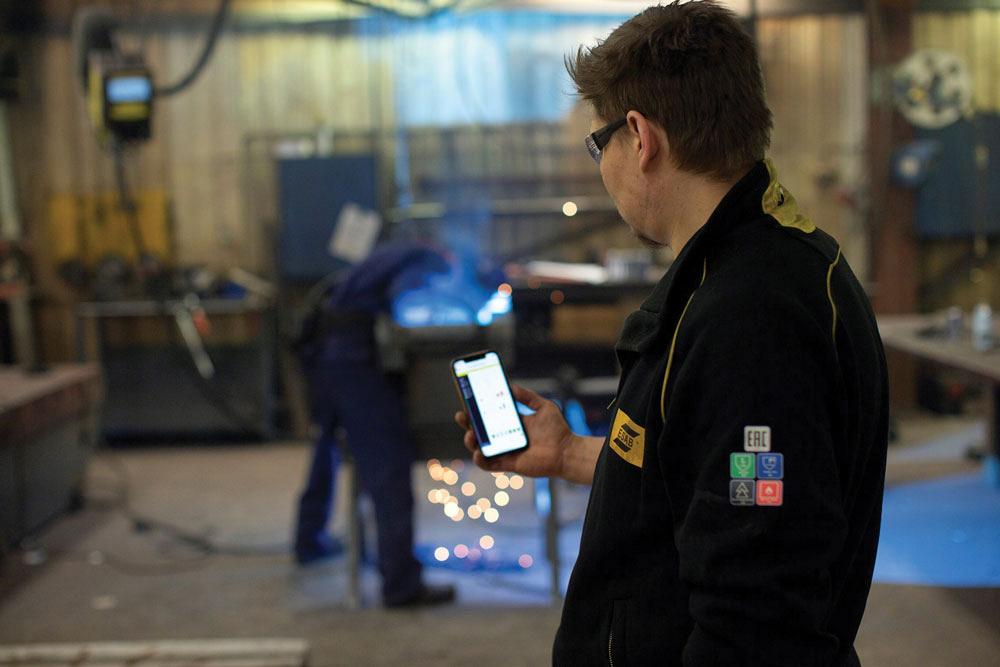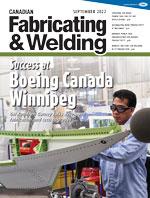Editor
- FMA
- The Fabricator
- FABTECH
- Canadian Metalworking
Welding data boosts change initiatives
New brand-agnostic platform hopes to encourage greater engagement
- By Rob Colman
- October 3, 2022
- Article
- Welding
Information is power and understanding the workflow of your welding operations through real-time data can give a shop the power to improve those operations. Welding power source manufacturers have appreciated this for a number of years and have been harnessing the data they are able to gather from newer machines to demonstrate how that data can be used to track arc-on time, voltage, and more.
One of the stumbling blocks in introducing consolidated data collection from a number of machines on shop floors is that many businesses run welding equipment from many different welding power source suppliers, each with their own data management systems.
ESAB is trying to encourage adoption of its data management system by creating InduSuite, a brand-agnostic portfolio of software applications.
“When it comes to digitalization, software is nothing new in the welding industry, but the way we’ve often approached it is that software is an add-on to the hardware,” said Jon Hofmann, director of product management, InduSuite. “As an industry, we have been selling products with software as an add-on.
“Software really hasn’t taken off in the welding industry because no one has taken that brand-agnostic approach to it. And that’s what we want to do with this platform. We’re not hiding that we’re owned by ESAB, but it’s very important that we support not only our own products but all brands of products. That’s our ambition, to build a software suite of products that can be used regardless of equipment or filler metal you’re using because we believe there’s so much you can do with digitalization to improve productivity, to improve quality, and traceability.”
Real-life Impact
Hofmann has many examples of companies that have benefitted from gathering weld data.
“For example, one of our customers, a Finnish manufacturer of mining equipment, increased arc-on time to 20 per cent (about double the industry average),” he noted. “They achieved this by gathering data. They had an assumption of how efficient they were, and when they realized that this wasn’t the case, they went out on the floor to see why. And they learned that they lacked the tools they needed to prep the weld joints for welding. Every welder needed to go 20 m to get the tool necessary from a common tool crib; they wasted a lot of time gathering tools to prepare their jobs. In that case, they moved those tools closer to employees. It sounds obvious, but it’s something they could only realize when they continuously measure and look at the data.”
This firm used its data to simply improve manual welding operations. But others have used data to confirm the business case for automating certain processes.
“Examining the data can help make sure you will get the return on investment that you are looking for from mechanization or automation,” said Hofmann. “It can help determine where that investment makes the most sense.”
The Platform
Hofmann accepts that a company using all ESAB machines will still get the most out of new platform. But with universal connector, key data like arc-on time, current, and voltage can be pulled from any machine to get the critical data to help a company begin it’s digitalization journey.
“We want to start collaborating with other brands, certainly,” said Hofmann. “We will definitely be working toward that, and in fact, the first third-party software developed for the platform will be coming out later this year.”
For those already using ESAB software, Hofmann notes that the platform creates a single log-in for all applications, and the ability to share data more easily among ESAB products like WeldCloud Productivity, WeldCloud Fleet, WeldCloud Notes, and CutCloud.
“It’s easy now, for instance, to match your welding certificates with your weld sessions to ensure that all your work properly complies with that WPS,” said Hofmann. “Ultimately, we want the platform to help shops track their parts from nesting straight through final assembly. That traceability is becoming much more important for certain companies and their suppliers.”
Getting Started
Hofmann noted that data management in weld operations can play an important role in many ways, including:
- Ensuring compliance by developing welding and cutting procedures in accordance with standards and regulations.
- Improving productivity with offline programming of robot, welding, and cutting applications.
- Tracking and analyzing welding and cutting productivity, quality, and consumables usage.
- Maintaining fleet equipment in optimal working conditions.
- Ensuring accountability and oversight of all key welding and cutting activities.
Sometimes it’s figuring out where to begin that can be the biggest challenge, though. The key is to take it step-by-step.
“Normally, we would look at rolling this out at five to 10 machines to start with,” said Hofmann. “We would run a pilot over one to three months. At that point, you evaluate what the main opportunities you’ve found are, then make the decision whether or not to roll it out to your entire facility. Because some shops have tacking stations, there may be some welding stations that are not critical in your production flow, so normally we see rollouts in about 75 to 80 per cent of a company’s operations. But it is very important to do a pilot first.”
This technology can bring benefits to smaller shops as well, of course; the cost savings are just that much greater if you have more machines.
“Having the data gives you a place from where you can begin to think more strategically about your welding operations,” said Hofmann.
Editor Robert Colman can be reached at rcolman@canadianfabweld.com.
InduSuite, indusuite.com
About the Author

Rob Colman
1154 Warden Avenue
Toronto, M1R 0A1 Canada
905-235-0471
Robert Colman has worked as a writer and editor for more than 25 years, covering the needs of a variety of trades. He has been dedicated to the metalworking industry for the past 13 years, serving as editor for Metalworking Production & Purchasing (MP&P) and, since January 2016, the editor of Canadian Fabricating & Welding. He graduated with a B.A. degree from McGill University and a Master’s degree from UBC.
subscribe now


Keep up to date with the latest news, events, and technology for all things metal from our pair of monthly magazines written specifically for Canadian manufacturers!
Start Your Free Subscription- Industry Events
Automate 2024
- May 6 - 9, 2024
- Chicago, IL
ANCA Open House
- May 7 - 8, 2024
- Wixom, MI
17th annual Joint Open House
- May 8 - 9, 2024
- Oakville and Mississauga, ON Canada
MME Saskatoon
- May 28, 2024
- Saskatoon, SK Canada
CME's Health & Safety Symposium for Manufacturers
- May 29, 2024
- Mississauga, ON Canada





















